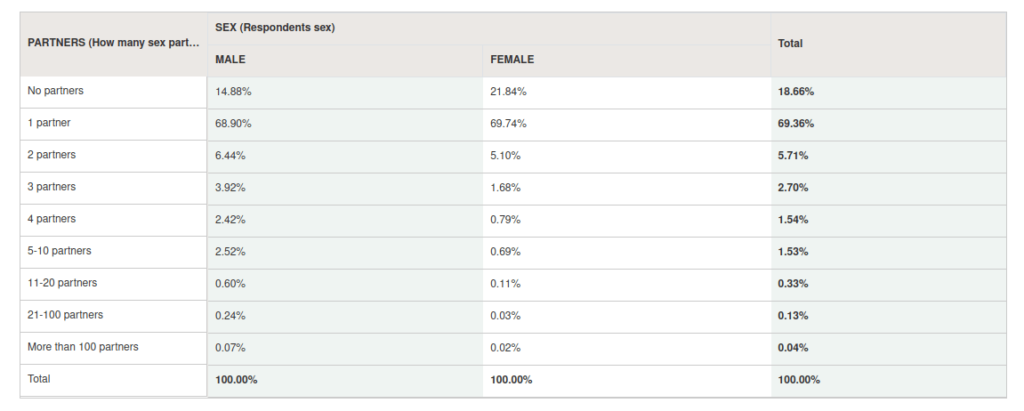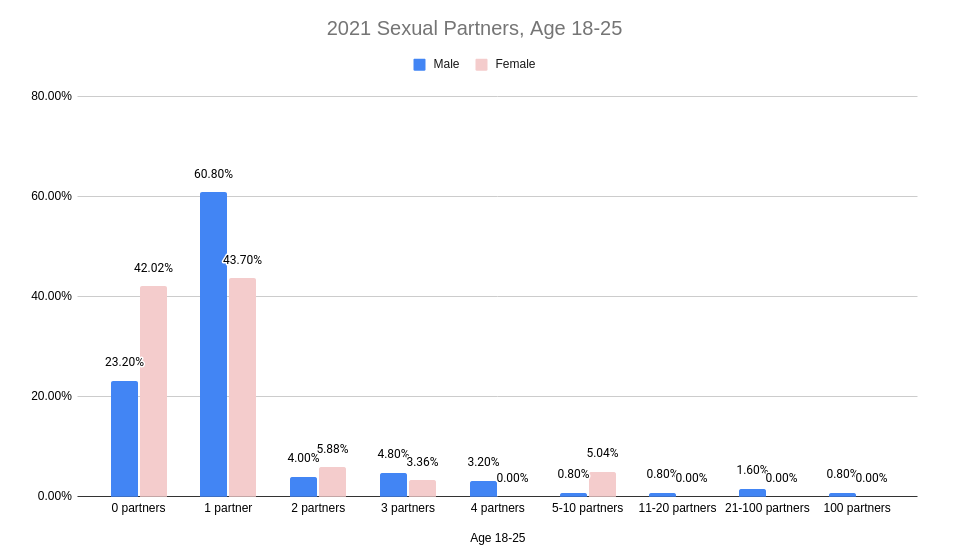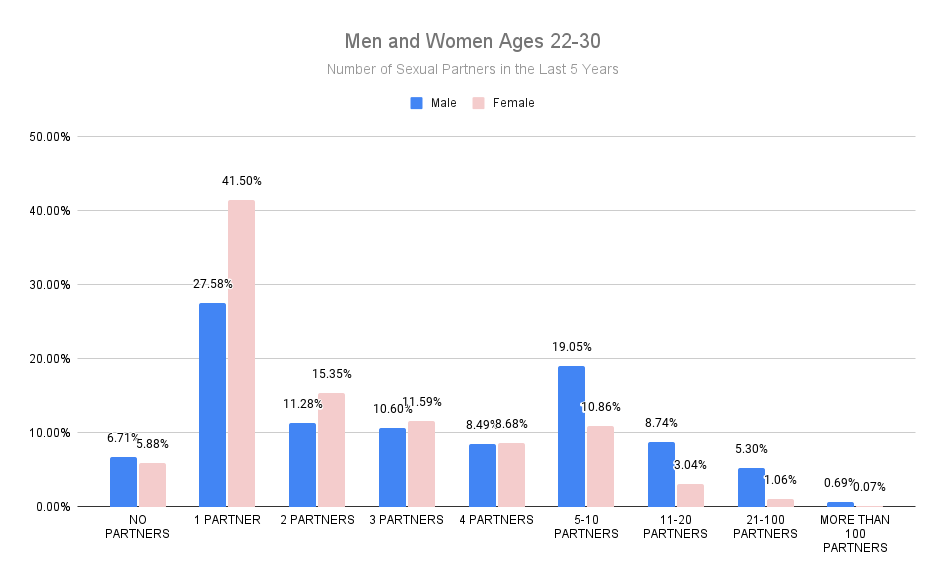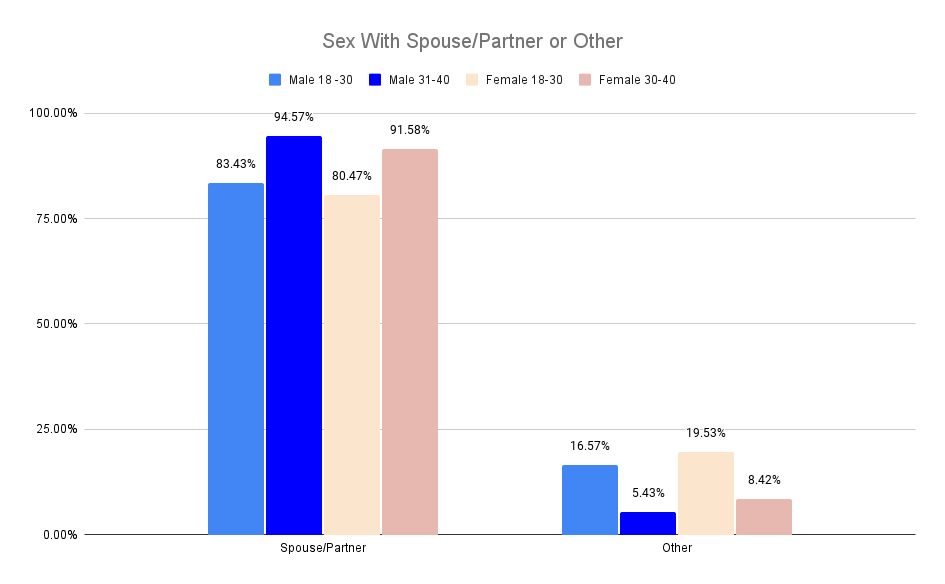Enjoy DatePsychology? Consider subscribing at Patreon to support the project.
In 2019 and 2020 there were popular reports of growing sexlessness for young men and women. The top Google search result for 2019 on this topic was this article from the Washington Post. Citing the 2018 General Social Survey, a large annual representative sample of Americans, the WP noted 23% of young adults aged 18-29 did not have sex within the past year. 28% of men and 18% of women reported not having sex.
The Internet ran with this information. “A whole 30% of men are not having sex!” Interpretations of this data included: lower marriage rates, more young people living at home, lower young adult incomes, social media and the impact of online dating. The conservative think-tank Institute for Family Studies interpreted the lower sex rate positively and as an argument for early marriage. The manosphere cited this as evidence of wild female promiscuity and the marginalization of men into incels (involuntarily celibates).
I looked at the recent 2021 General Social Survey data to see what the most recent data show and to see if this trend has continued.
General Partners by Gender, Total
The data show that promiscuity is low. 88% of all respondents reported having not had sex, or having had only one sexual partner, within the entire year of 2021.
More women than men have not had sex within the last year. Approximately 15% of men report having not had sex within the year of 2021, while 22% of women had no sexual partners. This means sexlessness is also moderately low. Sexlesness has decreased slightly for men from 2019-2020, but increased slightly for women.
Few men and women have had high numbers of sexual partners within a one year period. However, men report having had more sexual parnters than women at ranges above two partners. Approximately six times as many men (.60%) than women (.11%) report falling within 11-20 partners. Eight times as many men (.24%) than women (.03%) report having had between 21-100 partners.
A chi-square test showed a significant relationship between sex and number of sexual partners X2 (8, N = 36,051) = 785.41, p < 0.001. Men have more sexual partners than women on average.
But remember: statistical significance is not a measure of magnitude. You can look at the descriptive statistics or visualization and see that men and women have a reasonably similar number of sexual partners:

Sexual Partners by Gender, Ages 18-25
“But it’s youth sexlessness! Boomers with tradwives are skewing the result.”
The distribution for ages 18-25 is similar to the general population statistics above. Approximately 84% of young men and 86% of young women have had between zero to one sexual partner within the past year.
Young women are more likely than young men to report having had no sexual partners at 42% for women to 23% for men. Young men are more likely than young women to report having had one sexual partner at approximately 61% for men to 44% for women.

Sexual Partners by Gender, Ages 26-30
Between ages 26 and 30, even more people have had sex within the last year. Just 9% of men and 16% of women have not had sex within the last year.
The number of partners remained fairly stable for men, from approximately 61% in the 18-26 age group to 64%. In the 26-30 age group. Women increased from 44% in the 18-25 age group to 69% in the 26-30 age group.
A larger percentage of men and women have also had sex with more partners in the 26-30 age group. Men remained very stable at 4% for two partners in both groups, while women decreased from 6% to 4%. Men with three partners dropped approximately 1% and women with three partners increased by half a percent. For 4 partners, men increased by 1.6% and women decreased to a percentage below the display threshold.
At 5-10 partners, however, men increased from 1% to 9% and women increased from 5% to 6.6%.

The Perpetually Sexless, or Celibates
The General Social Survey gives us the partnrs5 variable, which tells us the number of sexual partners a respondent reports having within the last five years. This can be used as a rough proxy for virginity, short term celibacy, or “inceldom.” As this shows sexlessness within the last five years, grouping ages 22-30 gives a picture of what percentage of young adults are not having sex.
Approximately 7% of men and 6% of women between ages 22-30 have not had sex within the last five years.
More women (41%) than men (27%) report having had sex with only one partner in the last five years. More women report within the ranges of 1-4 partners, while more men report within the ranges consisting of greater than 5 partners. Past research has consistently shown men are more promiscuous on average and this may reflect that.
The total percentage of men who have had between 1-4 partners within the last five years is approximately 58%, while the total percentage is 77% for women. Most people, and a large majority of women, are having less than one new partner on average per year. The remaining 42% of men and 23% of women are having at least one new partner per year on average.

Most people are having sex with a committed partner or married spouse. Approximately 83% of men and 80% of women between the age of 18 and 30 reported having sex with a committed partner. For ages 31-40, these figures increased to 95% for men and 92% for women. 17% of men and 20% of women between age 18 and 30 reported having sex with someone other than a spouse or partner. Between ages 31 and 40 these figures declined to 5% for men and 8% for women.
Casual Sex or Committed Sex?
“In modern dating, women only have hook-ups with Chads on Tinder!”
Most people are having sex with a committed partner or married spouse. Approximately 83% of men and 80% of women between the age of 18 and 30 reported having sex with a committed partner. For ages 31-40, these figures increased to 95% for men and 92% for women. 17% of men and 20% of women between age 18 and 30 reported having sex with someone other than a spouse or partner. Between ages 31 and 40 these figures declined to 5% for men and 8% for women.

Summary; Or, responses to common objections.
“Sluts are riding the Chad cock-carousel!”
Not really. Young men and women are not as promiscuous as you think. It is a well-observed trend in the research that we overestimate the amount of sexual activity and relationship success of others. The image of high promiscuity in youth may be repeated in popular culture and social media, but the data do not show it.
Most sexually active men and women are restricting their sexual intercourse to a single partner over the course of the year. Most are having sex within the context of marriage or committed relationships.
“80% of women are having sex with 20% of the men!”
The so-called “80/20 rule” does not play out empirically. This figure was initially based on a dataset of Tinder swipes, not mate selection. 80/20 is a meme and has never been a real measure of sexual behavior outcomes. Fewer than 20% of men and women are having regular sex with more than one partner. Men and women both have a similar distribution of sexual partners. This distribution has been the same in the annual GSS datasets since the 1970s and replicated consistently across the research.
There is a minority of promiscuous men and women. They are mostly hooking up with each other. This is part of an observed pattern in mate selection called assortative mating.
“Normies are all incels now.”
Sexlessness is moderate in early adulthood and drops substantially in the mid to late 20s. Reports from 2019 and 2020 on young adult sexlessness claimed ‘nearly 1 in 3 young men in the US report having no sex.’ This remains true for women within the 18-30 age group, but not for men. Fewer men than women are sexless in 2021. Yearly sexlessness is also not perpetual sexlessness, or involuntary celibacy. Fewer than ten percent of both men and women have not had sex within the past five years. The average young man and woman is having sex; typically with each other.
“Women are having all the sex.”
The data show women are having less sex than men. Women are more likely to report not having had sex within the past year. Women are also more likely to report low levels of sexual partners, or no sexual partners, within the last five years. The manosphere has coined terms such as “cock carousel” and “AWALT” (“all women are like that”) to describe what they perceive to be rampant female promiscuity. The data do not show rampant female promiscuity. It is a figment of anecdote-fueled imaginations.
“Hook-up culture.”
Most sex is with spouses or committed partners, even in young to early adulthood. Men and women have sex with spouses and committed partners at very similar rates.
“The statistics are wrong and women lie.”
I don’t recall anyone claiming the statistics were wrong in 2019-2020 when the Internet ran wild with the claim that 30% of men were not having sex — based on the exact same annual GSS data. This is clearly motivated reasoning and an excuse to dismiss the data.
However, please see my next article for a summary of the science showing why these statistics are almost certainly not wrong.
11 comments
So across the board, you’re saying men have more sex and more partners than women. How is this possible? Your numbers don’t add up.
The average guy is. Some aren’t. That’s why in huge populations like the US you need to look at the stats not anecdotal stories, as the author of this piece points out. Large numbers of people are doing lots of things – but that still can be a drop in the bucket compared to the population. Note fewer than 10% of men haven’t had sex within the last 5 years and if you are including the 18 year olds in your annual numbers that’s going to exclude a lot of late bloomers.
Men also tend to hire professionals more than women so that adds to the body count for them. One woman and lots of guys.
“…Sexlessness is moderate in early adulthood and drops substantially in the mid to late 20s. Reports from 2019 and 2020 on young adult sexlessness claimed ‘nearly 1 in 3 young men in the US report having no sex.’ This remains true for women within the 18-30 age group, but not for men. Fewer men than women are sexless in 2021. Yearly sexlessness is also not perpetual sexlessness, or involuntary celibacy. Fewer than ten percent of both men and women have not had sex within the past five years. The average young man and woman is having sex; typically with each other…..
“…Young men and women are not as promiscuous as you think. It is a well-observed trend in the research that we overestimate the amount of sexual activity and relationship success of others. The image of high promiscuity in youth may be repeated in popular culture and social media, but the data do not show it.
Most sexually active men and women are restricting their sexual intercourse to a single partner over the course of the year. Most are having sex within the context of marriage or committed relationships….”
The real nail in the coffin is:
“The so-called “80/20 rule” does not play out empirically. This figure was initially based on a dataset of Tinder swipes, not mate selection. 80/20 is a meme and has never been a real measure of sexual behavior outcomes. Fewer than 20% of men and women are having regular sex with more than one partner. Men and women both have a similar distribution of sexual partners. This distribution has been the same in the annual GSS datasets since the 1970s and replicated consistently across the research.
There is a minority of promiscuous men and women. They are mostly hooking up with each other. This is part of an observed pattern in mate selection called assortative mating.”
I remember decades ago a number of men I knew who would brag of their many conquests. It wasn’t that impressive as it was the same set of bar flies from a local bar they were all hooking up with……..
PS – the researcher answers your question as to how it is possible in the article they link to:
https://datepsychology.com/is-self-reported-sexual-partner-data-accurate/
Factor in sex workers and it makes a lot of sense
This is even more depressing… it means that i’m a complete loser in that 7% of sexless men. What a shame
The chart “The men and women 22- 30 in last 5 years” unveils disgusting nature of human sexual life, if you agree or not. I’m that 6.71% of men, so some goats used women at the column 5-10 partners, and then womens pervert path is descending from 1 to 5-10 partners… so exciting story! I’ll search for virgin girl or die trying, thanks!
It seems that the data on casual sex are somewhat mixed. many studies show that they are common in colleges. which contradicts the GSS data.
it is possible that the samples of such student surveys are simply unrepresentative since it seems doubtful that the majority of students participate in this
https://bedbible.com/hookup-culture-statistics/
The data of 5-10 partners for females ages 18-25 are inaccurate and unequivalent in the dataset compared with the bar graph.
This data is skewed and flawed. I know multiple females between ages 18-25 with body counts well over 30. This data is showing 0.0%
Complete lies to hide rampant female promiscuity.
“The data of 5-10 partners for females ages 18-25 are inaccurate and unequivalent in the dataset compared with the bar graph.”
Provide evidence. I checked the 2021 GSS results and I cannot find the same inaccuracy/unequivalency that you state exists.
“I know multiple females between ages 18-25 with body counts well over 30. This data is showing 0.0%”
Do you really think your cherry picked sample of 5 women aged 18-25 is less biased than a nationally representative sample? Go read what the anecdotal fallacy is. Besides, what’s the guarantee that the women you know actually have 30+ partners and aren’t lying to you?
“Complete lies to hide rampant female promiscuity.”
Go take a statistics class. There are no lies in this article. Please refer to these articles written by the author on sexual partner count reporting in surveys:
https://datepsychology.com/did-a-fake-polygraph-catch-women-lying-about-their-sexual-partner-count/
https://datepsychology.com/is-self-reported-sexual-partner-data-accurate/
“The data of 5-10 partners for females ages 18-25 are inaccurate and unequivalent in the dataset compared with the bar graph.”
Please provide evidence for this claim.
“This data is skewed and flawed. I know multiple females between ages 18-25 with body counts well over 30. This data is showing 0.0%”
There are several issues with this part of your comment:
1. The percentage the data shows is 0.00%, not 0.0%. This is important to note because the percentages in the bar graph are rounded figures, rounded to 2 decimal places. Any value less that 0.005%, when rounded to the nearest 2 decimal places will show 0.00%, which is what is present in the bar graph.
2. You use the anecdotal fallacy to justify your biases against the GSS data. Just because you know a few women who have 30+ sexual partner count(How do we even know if this is true and that you aren’t making things up?), that doesn’t mean that the GSS is wrong. Your sample is small and heavily biased(confirmation bias, selection bias, etc) whereas the GSS sample is nationally representative. I would suggest reading up on the anecdotal fallacy to understand why your unverifiable personal experience does nothing to counter the results found by the GSS.
tl,dr: The data is neither flawed nor skewed. What is flawed and skewed is your unverifiable anecdote.
“Complete lies to hide rampant female promiscuity.”
Yeah bud, you know just as well as I do that this is blatantly false. This is a perfect example of why anecdotes are not valid evidence. You are using your anecdote to make a hastily generalized claim about a phenomenon that neither occurs nor exists. Read the two points mentioned above.
Besides, the author has published several very good articles debunking this claim of rampant female promiscuity:
https://datepsychology.com/casual-sex-is-often-mismeasured-and-overestimated/
https://datepsychology.com/did-a-fake-polygraph-catch-women-lying-about-their-sexual-partner-count/
https://datepsychology.com/is-self-reported-sexual-partner-data-accurate/